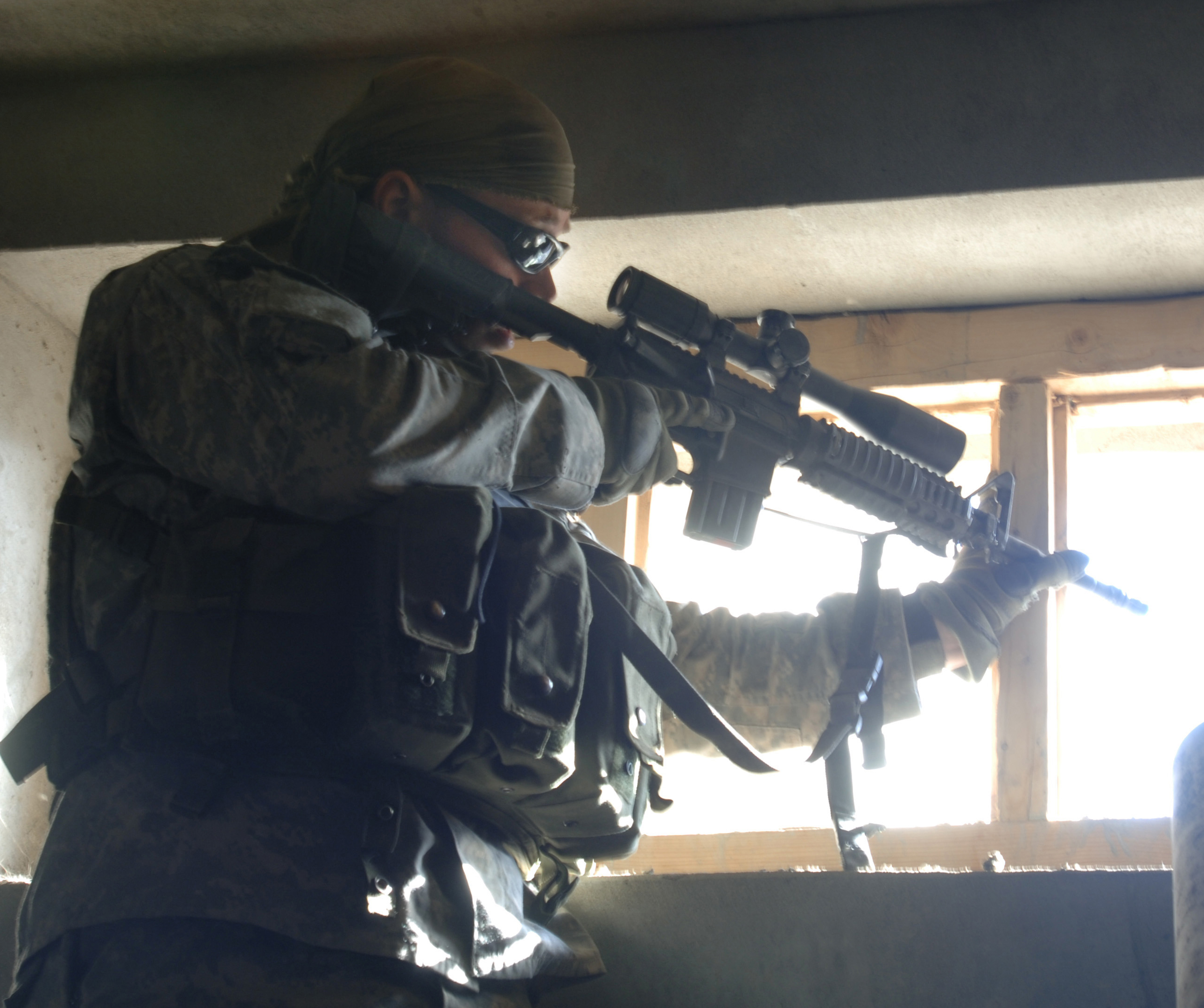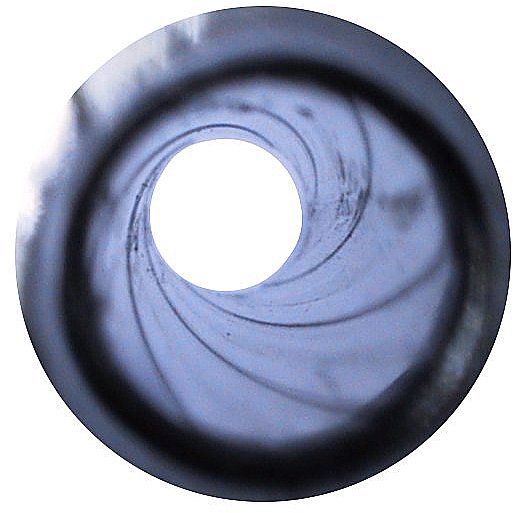|
Carabine à Tige
The carabine à tige (sometimes called a stem rifle or a pillar breech rifle) was a type of black-powder, muzzle-loading rifle invented by Louis-Etienne de Thouvenin. The method was an improvement of the invention of another Frenchman, Henri-Gustave Delvigne. Delvigne had developed chambered carbines and rampart rifle-muskets so that when forced against the chamber rim by ramming (with three strokes of a heavy ram), the bullet would become deformed and flatten, so as to expand in diameter against the inside of the bore, allowing the bullet to press against the rifling grooves. When fired, the bullet accompanied the rifling and spun. This was an early attempt to work around one of the greatest hindrances to the use of military rifles; in order for a rifle to impart the proper spin to a projectile, the projectile must fit snugly inside the barrel to engage the rifling grooves. The problem, however, was that the black powder used at that time would quickly produce a thick layer res ... [...More Info...] [...Related Items...] OR: [Wikipedia] [Google] [Baidu] |
Chasseurs
''Chasseur'' ( , ), a French term for "hunter", is the designation given to certain regiments of French and Belgian light infantry () or light cavalry () to denote troops trained for rapid action. History This branch of the French Army originated during the War of the Austrian Succession when, in 1743, Jean Chrétien Fischer was authorized by the Marshal de Belle-Isle to raise a 600 strong mixed force of infantry and cavalry. It was called '' Chasseurs de Fischer.'' During the remainder of the 18th century various types of light troops () were employed within the French army, either as independent units or as companies within existing regiments. In 1788, there were 8 battalions of chasseurs, and in March 1793 this was expanded to 21 battalions. The first battalions of Chasseurs raised by 1788 included: * (1st) '' Chasseurs Royaux de Provence'' * (2nd) ''Chasseurs Royaux de Dauphiné'' * (3rd) '' Chasseurs Royaux Corses'' (Corsican) * (4th) '' Chasseurs Corses'' (Corsi ... [...More Info...] [...Related Items...] OR: [Wikipedia] [Google] [Baidu] |
Rifles Of France
A rifle is a long gun, long-barreled firearm designed for accurate shooting and higher stopping power, with a gun barrel, barrel that has a helical or spiralling pattern of grooves (rifling) cut into the bore wall. In keeping with their focus on accuracy, rifles are typically designed to be held with both hands and braced firmly against the shooter's shoulder via a buttstock for stability during shooting. Rifles are used in warfare, law enforcement, hunting and shooting sports, target shooting sports. The invention of rifling separated such firearms from the earlier smoothbore weapons (e.g., arquebuses, muskets, and other long guns), greatly elevating their accuracy and general effectiveness. The raised areas of a barrel's rifling are called ''lands''; they make contact with and exert torque on the projectile as it moves down the bore, imparting a spin. When the projectile leaves the barrel, this spin persists and lends gyroscopic stability to the projectile due to conservatio ... [...More Info...] [...Related Items...] OR: [Wikipedia] [Google] [Baidu] |
Minié Rifle
The Minié rifle was a rifled musket used by the infantry of a number of countries in the mid-19th century. A version was adopted in 1849 following the invention of the Minié ball in 1847 by the French Army captain Claude-Étienne Minié of the Chasseurs d' Orléans and Henri-Gustave Delvigne. The bullet was designed to allow rapid muzzle loading of rifles and was an innovation that brought about the widespread use of the rifle as the main battlefield weapon for individual soldiers. The French adopted it following difficulties encountered by the French army in North Africa, where their muskets were overtaken in range by long-barreled weapons which were handcrafted by their Algerian opponents. Mechanism The rifle used a conical-cylindrical shaped soft lead bullet, slightly smaller than the barrel bore, with three exterior grease-filled peripheral grooves and a conical hollow in its base. When fired, the expanding gas forcibly pushed on the skirted base of the bullet, spread ... [...More Info...] [...Related Items...] OR: [Wikipedia] [Google] [Baidu] |
Claude-Étienne Minié
Claude-Etienne Minié (13 February 1804 – 14 December 1879) was a French military instructor and inventor famous for solving the problem of designing a reliable muzzle-loading rifle by inventing the Minié ball in 1846, and the Minié rifle in 1849. He succeeded the pioneering work of Henri-Gustave Delvigne and Louis-Étienne de Thouvenin. Minié served in a number of African campaigns with the Chasseurs, after which he was eventually promoted to captain. In 1846 he designed the Minié ball, a cylindrical bullet with a conical hollow in the base which expanded when fired. This projectile, combined with his rifle, resulted in a major improvement in firearm accuracy. The French government rewarded Minié with some 20,000 francs and installed him as a member of the staff at the Vincennes military school. In 1858 he retired from the French Army with the rank of colonel and later served as a military instructor for the khedive of Egypt and as a manager at the Remington Arms C ... [...More Info...] [...Related Items...] OR: [Wikipedia] [Google] [Baidu] |
Minié Ball
The Minié ball, or Minie ball, is a type of hollow-based bullet designed by Claude-Étienne Minié for muzzle-loaded, rifled muskets. Invented in 1846 shortly followed by the Minié rifle, the Minié ball came to prominence during the Crimean War and the American Civil War where it was found to inflict significantly more serious wounds than earlier round musket balls. Both the American Springfield Model 1861 and the British Pattern 1853 Enfield rifled muskets, the most common weapons found during the American Civil War, used the Minié ball. Rifling, the addition of spiral grooves inside a gun barrel, imparts a stabilizing spin to a projectile for better external ballistics, greatly increasing the effective range and accuracy of the gun. Before the introduction of the Minié ball, which themselves needed greasing, balls had to be rammed down the barrel, sometimes with a mallet, because gunpowder residue would foul a rifled bore after a relatively small number of shots, ... [...More Info...] [...Related Items...] OR: [Wikipedia] [Google] [Baidu] |
Marksmen
A marksman is a person who is skilled in precision shooting. In modern military usage this typically refers to the use of projectile weapons such as an accurized scoped long gun such as designated marksman rifle (or a sniper rifle) to shoot at high-value targets at longer-than-usual ranges. The proficiency in precision shooting is known as a shooter's marksmanship, which can be used to describe both gunnery and archery. Description In common usage, "sharpshooter" and "marksman" are synonymous. Within the specialized fields of shooting sports and military usage, however, sharpshooter and marksman each refer to different levels of skill. Specifically, in the US Army, "marksman" is a rating below "sharpshooter" and "expert". Four levels of skill are generally recognized today in American military and civilian shooting circles: unqualified, marksman, sharpshooter, and expert. Marksmanship badges for the three qualified levels are commonly awarded to both civilian and military s ... [...More Info...] [...Related Items...] OR: [Wikipedia] [Google] [Baidu] |
Jäger (military)
Jäger, Jager, or Jaeger (), meaning "hunter" in German, may refer to: * Jäger (surname), also Jaeger and Jæger, including a list of people and fictional characters with the surname Fictional characters *Jaeger, in the television series '' Altered Carbon'' *Jaeger, a group of vampire hunters in the anime series '' Sirius the Jaeger'' *Jaegers, a group in the ''Akame ga Kill!'' manga and anime *Jaegers, piloted robots used to fight alien monsters in the 2013 film '' Pacific Rim'' and the 2018 sequel *Jaeger (alt. Jäger; Yeager), refers to a family from the manga series Attack on titan and it’s anime adaptation anime series of the same name. Known member of the family: Eren Yeager, Grisha Yeager, Zeke Yeager In biology *Jaeger, the North American name for the smaller species of the skua family of seabirds *Jaeger 70 Jaeger 70 (also known as Munson) is a hybrid of two American grape species, '' Vitis lincecumii'' and '' Vitis rupestris'' developed by Hermann Jaeger (1 ... [...More Info...] [...Related Items...] OR: [Wikipedia] [Google] [Baidu] |
Rifling
Rifling is the term for helical grooves machined into the internal surface of a firearms's barrel for imparting a spin to a projectile to improve its aerodynamic stability and accuracy. It is also the term (as a verb) for creating such grooves. The opposite of rifling is smoothbore. Rifling is measured in ''twist rate'', the distance the rifling takes to complete one full revolution, expressed as a ratio with 1 as its base (e.g., 1:). A shorter distance/lower ratio indicates a faster twist, generating a higher spin rate (and greater projectile stability). The combination of length, weight, and shape of a projectile determines the twist rate needed to gyroscopically stabilize it: barrels intended for short, large-diameter projectiles such as spherical lead balls require a very low twist rate, such as 1 turn in 48 inches (122 cm). Barrels intended for long, small-diameter projectiles, such as the ultra-low-drag 80-grain 0.223 inch bullets (5.2 g, 5.56&nb ... [...More Info...] [...Related Items...] OR: [Wikipedia] [Google] [Baidu] |
Rifling
Rifling is the term for helical grooves machined into the internal surface of a firearms's barrel for imparting a spin to a projectile to improve its aerodynamic stability and accuracy. It is also the term (as a verb) for creating such grooves. The opposite of rifling is smoothbore. Rifling is measured in ''twist rate'', the distance the rifling takes to complete one full revolution, expressed as a ratio with 1 as its base (e.g., 1:). A shorter distance/lower ratio indicates a faster twist, generating a higher spin rate (and greater projectile stability). The combination of length, weight, and shape of a projectile determines the twist rate needed to gyroscopically stabilize it: barrels intended for short, large-diameter projectiles such as spherical lead balls require a very low twist rate, such as 1 turn in 48 inches (122 cm). Barrels intended for long, small-diameter projectiles, such as the ultra-low-drag 80-grain 0.223 inch bullets (5.2 g, 5.56&nb ... [...More Info...] [...Related Items...] OR: [Wikipedia] [Google] [Baidu] |
Henri-Gustave Delvigne
Henri-Gustave Delvigne (April 10, 1800 in Hamburg – October 18, 1876 in Toulon) was a French soldier and inventor. He became a captain in the French infantry service, from which he resigned on the outbreak of the 1830 July Revolution. Delvigne revolutionized rifle technology and rendered it proper as a weapon. Chambered magazines In 1826 Delvigne invented a new method which greatly simplified the use of rifled guns, and created a rifle known by his name. The problem was that the black powder used at that time would quickly produce a thick layer residue of fouling. After only three or four shots, a typical muzzle-loading rifle could only be reloaded by using a mallet to force the bullet down the fouled barrel. Delvigne addressed this problem by producing a rifle chamber (firearms), chamber smaller than the caliber, bore, with which it was connected by a Sphere, spherical surface equal in radius to the projectile, ball used. The Gunpowder, powder was poured from the muzzle ... [...More Info...] [...Related Items...] OR: [Wikipedia] [Google] [Baidu] |



